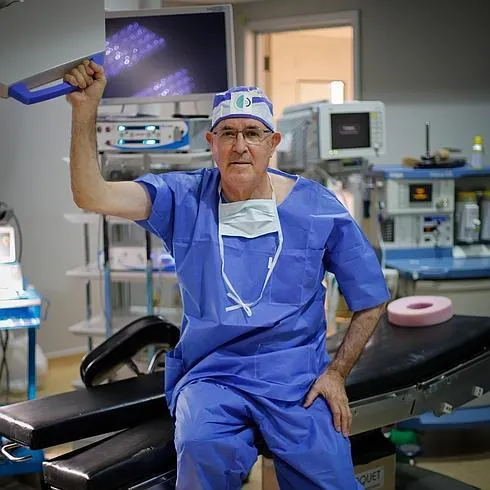«Cancer kills you, diabetes crushes your life before killing you.It is a very serious disease, which leaves you blind, that leaves you without kidneys and that slowly kills you from myocardial infarction with amputation of the limbs, ”Dr. Carlos Ballesta, director of the Dr. Ballesta Laparoscopic Center, who hasHeadquarters at the Ruber International Hospital in Madrid, in Barcelona and at the Immaculate Hospital in Granada.
With more than 30 years of experience in general and digestive surgery, he is a pioneer and worldwide reference in minimally invasive laparoscopic surgery, a technique that uses as the first option and norm, to provide greater comfort and minimum pain.
Back to Granada
He began his medical career at the University of Granada, where he used five years to finish the six courses of the Medicine career.He did not exercise here, since he moved to Barcelona to obtain the degree of degree in 1974 and there began to shape a curriculum that has made him one of the most recognized specialists in digestive and laparoscopic surgery, to the point ofthat its center has the excellence distinction of the International Federation of Obesity Surgery (IFSO).
«We saw that those patients to whom we cured obesity by making a gastric 'by-pass'They are not obese, ”explains the doctor.That was in 2010. under strict controls proved to operate people without obesity but with type 2 diabetes.
«We operated more 300 patients and saw that it was cured.We made a special protocol for them, they had to have pancreatic reservation and they didn't have to have antibodies.That is, type 2 diabetes, the most common, which affects 90% of the population suffering from this disease.Seen the results, in 98% of the cases it was cured.We currently divide diabetes surgery into three groups: patients with obesity and diabetes, patients who have a few kilos and have diabetes, what is called diabnesity, and patients who are type 2 diabetic.
People who are with 80 insulin units, in fifteen days do not need it, and people who are being blind, return to their normal vision, ”details Dr. Ballesta, who three years ago decided to venture to return with his technique to Granada, where he studied and where he has a home, and today he attends and operates in his center patients from all over Andalusia, other regions such as Murcia or Castilla-La Mancha, and even people arriving from countries such as the United States, Arab Emirates, Russia, Italy, Great Britain, Catar or Saudi Arabia.
"46% of our patients are currently foreigners," says Ballesta, who since 1987 has performed with his medical team about 40,000 surgeries for laparoscopy, 3,000 of which have been for obesity and diabetes (metabolic surgery, in the slangdoctor).For now, this technique is only being applied in private health, but Ballesta believes that, over time, it will be incorporated into public health.«It is a matter of investing in the necessary media and training teams.This technique needs a lot of training ».An expert says that has trained numerous Spanish and foreign surgeons, who is 'Honoris Causa' by several universities in the world and a world eminence in the specialty of digestive surgery.
On type 2 diabetes
Type 2 diabetes is one of the most common forms of this disease.It lasts a lifetime and its main pathology is that there is a high level of sugar (glucose) in the blood.People who suffer from it, more than six million throughout Spain, are forced to depend on the external insulin administration, ahormone produced by the pancreas and is necessary to move blood sugar to the cells.Once in the cells, it is stored and the body uses it as energy.
When someone suffers from type 2 diabetes, adipocytes, hepatocytes and muscle cells do not respond correctly to that insulin.This is called insulin resistance.As a result, blood sugar does not enter these cells in order to be stored as a source of energy.When sugar cannot enter cells, a high level is accumulated in the blood.It is the so -called hyperglycemia.
Usually, type 2 diabetes develops slowly over time.Most people with this disease are overweight or are obese at the time of diagnosis.The increase in fat makes the body difficult the use of insulin in the right way.Although this problem can also occur in thin people.This is more common in the elderly.Family history and genes play an important role.A low level of activity, a poor diet and excessive body weight around the waist increase risk.




